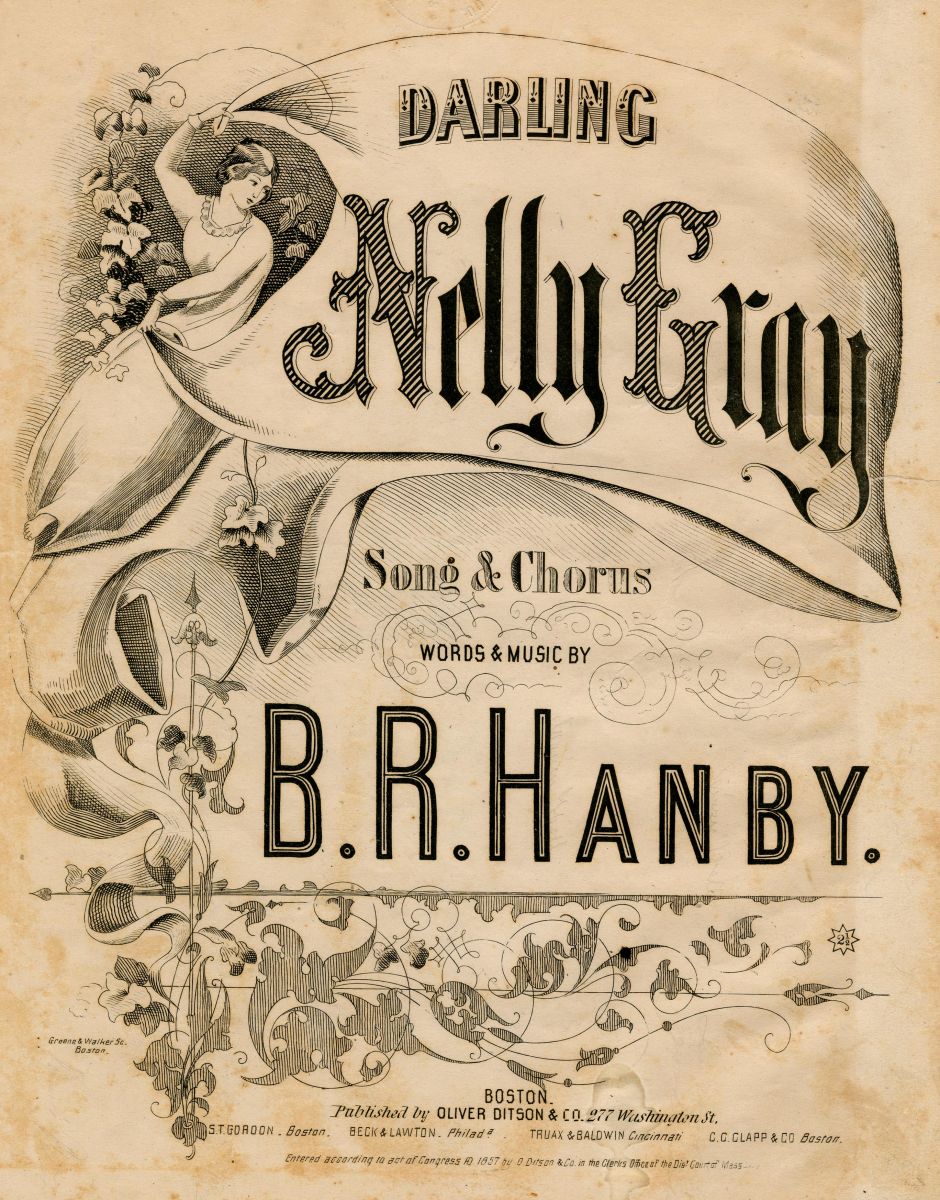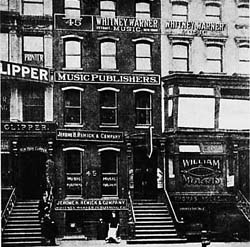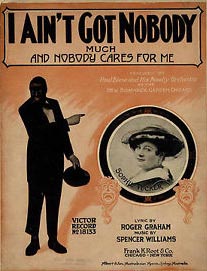
"Nelly Gray" sheet music courtesy of ohiohistory.wordpress.
All the music on this edition of Riverwalk Jazz was written at a time before jazz was a household word. These songs were composed between the late 1800s and 1917—the year America entered World War I. Many pop songs of this vintage have been adopted and revived by jazz musicians. Something about the melodies and chord changes of these compositions make them appealing to jazz players as a jumping-off point for improvisation. The synergy between early pop tunes and hot jazz players has appeal for audiences as well. In 1927 Red Nichols and His Five Pennies recorded the 1916 vaudeville number “Ida, Sweet as Apple Cider,” and it sold over a million copies. “Ida” remains a popular jam tune. On this broadcast we’ll take a look at why these pre-WWI songs have aged so well and continue to be popular with classic jazz bands today.
In the late 1800s, if you wanted to have the hottest new popular song for your personal collection, you bought the sheet music and learned how to play it yourself. It was a time before the mass marketing of phonograph records, radio broadcasting and talking pictures. In New York City, at this time, in the area around Union Square theaters, dance halls and publishing houses formed a beehive of songwriting activity. This center was dubbed “Tin Pan Alley” and sheet music was very big business.

Tin Pan Alley, 1914. Photo in public domain.
Americans got almost all their music live in concerts, musicals, and vaudeville shows. Or, the homemade variety performed by family and friends in parlors and on front porches. In band shells and town squares across the country the “March King” John Phillip Sousa presented outdoor concerts; and if Sousa wasn’t on hand to perform his music in person, his compositions were a mainstay in the repertoire of local brass bands everywhere. The strains of hymns, Viennese waltzes and patriotic marches floated in the air. Every town had its own opera house or vaudeville theater to showcase road show performances by superstars like Sophie Tucker, billed as “The Last of the Red Hot Mommas.” America hummed and whistled tuneful, memorable melodies. “Pretty Baby.” “Poor Butterfly.” “The Skater’s Waltz.” Here, The Jim Cullum Jazz Band gives these and other early 20th century popular songs the Band’s unique hot jazz interpretation.

"I Ain't Got Nobody" sheet music. Image in public domain.
In 1915 “I Ain't Got Nobody“ hit it big for African-American songwriter Spencer Williams. Jazz players like this tune because it has an unexpected chord change under the syllable ‘BOD-y,’ a pleasant surprise to the ear.
“Oh, My Darling Nelly Gray“ goes all the way back to 1856. Written by Benjamin Russell Handy, it was popular in the Civil War era. The lyric about a love lost through untimely death is typical of the day: Oh My Darling Nellie Gray, they have taken you away. Jim and the Band capture the forlorn sentiment of Nellie Gray’s story in their instrumental version, featuring the melancholy lament of Cullum Band member Evan Christopher’s clarinet.
Wilbur Sweatman, born in 1882, was an early jazz figure and a vaudevillian known for his flamboyant showmanship. He was famous for his novelty act where he would (somehow) manage to play three clarinets at once. He wrote a number of popular tunes and his biggest hit, “Down Home Rag“ first published in 1911, was revived and popularized again in the 1940s by Lu Watters Yerba Buena Jazz Band. The Jim Cullum Jazz Band’s version, heard here, features a 9-piece ensemble with tuba player Mike Walbridge and cornetist Leon Oakley sitting in.
Emil Waldteufel was known as the French ‘Waltz King,’ the Parisian counterpart of Vienna’s Johann Strauss. In 1882 Waldteufel wrote his famous “Skater's Waltz.“ The opening strain conjures up an image of a couple gracefully gliding across a frozen pond on a cold winter day. Jim Cullum’s arrangement for jazz band has the sound of the late-1930s Bob Crosby Bob Cats squarely in mind for their “Skater’s Waltz in Swing Time.”
.jpg)
Portrait of young Sidney Bechet. Photo in public domain.
Another piece of classical music that made a successful migration into the jazz world is a signature piece from the playing of Sidney Bechet called, “Song of Song’s.” First introduced in 1914 by the British composer and conductor Harold Vickers, who mysteriously composed this number under the pseudonym “Moya,” the song had both English and French lyrics, and proved to be popular on both sides of the Atlantic. Its French title roughly translates as “Song of the Broken Heart.” New Orleans-born jazz saxophone and clarinet legend Sidney Bechet brought “Song of Songs” to the jazz world and made the mesmerizing melody his own. Clarinetist Evan Christopher is featured here with Jim Cullum and his band.
The renowned Mexican composer Manuel Ponce also wrote his best-known popular song “Estrellita“ in 1914. It soon became an international hit. Guest soloists, clarinetist Henry Cuesta and violinist Johnny Frigo, weave their jazz improvisations around the soaring melody.

Pianist Tony Jackson in 1910's Chicago. Photo in public domain.
African-American pianist and entertainer Tony Jackson made a name for himself playing piano in the brothels of early 20th century New Orleans, but he published his biggest hit “Pretty Baby“ in 1915 in a Broadway show called World of Pleasure with a score by Sigmund Romberg. The next year, the Schubert brothers interpolated “Pretty Baby” into their revue The Passing Show of 1916 where it became an even greater hit. The ingénue vocalist in The Passing Show sang Tony Jackson’s “Pretty Baby” in the voice of a toddler, backed by a lineup of chorus girls dressed like baby dolls.
Stories abound about how a brothel piano player like Jackson wound up having a hit tune in a Broadway show in 1916. It’s hard to tell which one to believe, but it’s a great example of the incredible synergy going on in American music as early jazz musicians adapted pop songs to jazz rhythms and ragtime composers were busily mainstreaming their tunes.
In 1916 Raymond Hubble composed a haunting melody and titled it “Poor Butterfly.“ The lyric by John Golden tells the tragic love story of Puccini’s opera Madame Butterfly. “Poor Butterfly” was introduced in 1916 in a spectacular production called The Big Show. The sheet music for this number sold over two million copies and jazz artists from Red Nichols in the 20s to Sarah Vaughan in the 50s have recorded the tune. The instrumental version heard here features Cullum Band clarinetist Ron Hockett with the rhythm section.
The syncopated rhythmic patterns of “At A Georgia Camp Meeting“ from 1897 are characteristic of the Cake Walk, a dance craze of the late 19th century. This tune is of particular interest to classic jazz musicians like The Jim Cullum Jazz Band because the syncopated melody of the opening phrase clearly suggests ideas for improvisers to draw on.

“Ida (Sweet as Apple Cider) “ sheet music. Image in public domain.
“Ida (Sweet as Apple Cider) “ is a simple tune often sung by Eddie Cantor on the vaudeville stage. It was written in 1916 and popularized by the 1919 musical Roly Boly Eyes. Red Nichols and His Five Pennies revived it with their jazz band recording in 1927, and it remains a staple of classic jazz bands. Our version features the trombone duo of Bill Allred and Mike Pittsley.
“Hiawatha,” composed by Charles N. Daniels in 1903, is a favorite of Jim Cullum who remembers “old-timers” in New Orleans telling him they knew the tune as “Lizard on a Rail.” The form of the piece is that of a classic three-part march.
Photo credit for Home Page: "Nelly Gray" sheet music courtesy of ohiohistory.wordpress.
Text based on Riverwalk Jazz script by Margaret Moos Pick ©2001

